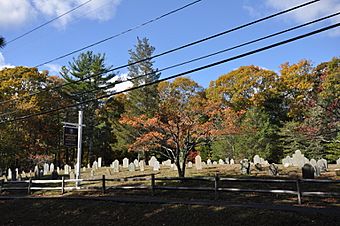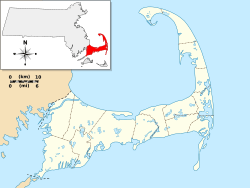Ancient Burying Ground facts for kids
Quick facts for kids |
|
|
Ancient Burying Ground
|
|
 |
|
| Location | Phinney's Lane, Barnstable, Massachusetts |
|---|---|
| Area | 0.75 acres (0.30 ha) |
| MPS | Barnstable MRA |
| NRHP reference No. | 87000283 |
| Added to NRHP | March 13, 1987 |
The Ancient Burying Ground, also known as Phinney's Lane Cemetery, is a very old and important cemetery in Barnstable, Massachusetts. It is the oldest cemetery in the village of Centerville. This historic site is the only part of Centerville's early colonial past that still exists today. It was added to the National Register of Historic Places in 1987.
Contents
Exploring the Ancient Burying Ground
The Ancient Burying Ground is located in the northern part of Centerville village. You can find it on the northwest side of Phinney's Lane, between Main Street and the Old Post Road. It's a roughly rectangular area, about 0.75 acres in size.
What You'll See There
The side of the cemetery facing the street has a fence made of split rails. The other sides are surrounded by trees. These trees help separate the cemetery from the houses nearby. A private road runs along one side, leading to a house behind the cemetery.
Looking at the Gravestones
Most of the gravestones in the cemetery face toward the street. The older gravestones are made of slate. They often have carvings of skulls or angels with wings. Newer markers are made from marble or granite. The oldest grave with a clear date belongs to Jonathan Hamblen, from 1743.
A Glimpse into Centerville's Past
This cemetery is the only remaining public building or place from Centerville's early colonial days. The area was once called Chequaquet. For a long time in the 1700s, not many people lived here.
Early Village Life
The small community that did exist was mostly along this part of Phinney's Lane. In the past, there was a gristmill (for grinding grain), a tavern, and a schoolhouse here. The village's first meetinghouse, a place for religious services and town meetings, was built in 1796. None of these original buildings are still standing today. However, a private house called the William and Jane Phinney House, built around 1730, does remain nearby.




